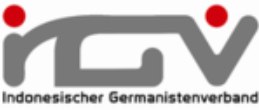EFFECTIVENESS OF NEARPOD LEARNING MEDIA IN LEARNING PERSONALPRONOMEN IM AKKUSATIV FOR SENIOR HIGH SCHOOL STUDENTS
Abstract
Pronomina has a big role in mastering German grammar. To master pronominal forms well, learning media is needed that can support the learning process. In today's modern era, learning media in the form of applications is an option amid the widespread use of smartphones, one of which is NearPod. The purpose of this research is to find out: 1) Students' ability in mastering Personalpronomen im Akkusativ material before the use of NearPod media, 2) Students' ability to master Personalpronomen im Akkusativ after using NearPod, 3) The effectiveness of NearPod media in improving students' learning ability in Personalpronomen im Akkusativ, and 4) Students' response to NearPod media. The research method used in this research is quantitative with the type of Quasi Experiment. The population in this study were all students of class X in the even semester of the 2022/2023 school year at SMA Negeri 4 Cimahi with the sample being 30 students from class X IPA 2 as the experimental class and 30 students from class X IPA 3 as the control class. The findings of this study are: 1) The initial ability of students in the experimental class is included in the deficient category, while the control class is classified as a failed category, 2) After using NearPod, the ability of students in the experimental class is in the good category, while the control class is in the sufficient category, 3) Based on the results of the Independent Sample t-Test, the use of NearPod as a learning media for Personalpronomen im Akkusativ proved to be effective. This can be proven from the significance value (2-tailed) which is less than 0.05 (0.00 < 0.05). In other words, there is a significant effect between learning using NearPod and conventional learning on the mastery of Personalpronomen im Akkusativ. 4) The majority of learners approve the use of NearPod in learning Personalpronomen im Akkusativ.
Keywords: learning media, nearpod. personalpronomen im AkkusativFull Text:
PDFReferences
Arlinwibowo, J., Retnawati, H., & Kartowagiran, B. (2022). The impact of ICT utilization to improve the learning outcome: A meta-analysis. International Journal of Evaluation and Research in Education (IJERE).
Azhari. (2015). The role of educational media in improving the Arabic language skills of madrasah students. Scientific Journal of Didaktika: Scientific Media for Education and Teachers, 16(1), 43–60.
Bormida, G., Ponta, D., & Donzellini, G. (1997). Methodologies and tools for learning digital electronics. IEEE Transactions on Education, 40(4).
Dewi, S. Z., & Hilman, I. (2019). The use of ICT as an innovative learning resource and media in elementary schools. Indonesian Journal of Primary Education, 2(2), 48–53.
Hori, R., & Fujii, M. (2021). Impact of Using ICT for Learning Purposes on Self-Efficacy and Persistence: Evidence from Pisa 2018. Sustainability. https://doi.org/10.3390/SU13116463.
Josué, A., Bedoya-Flores, M., Mosquera-Quiñonez, E., Mesías-Simisterra, Á., & Bautista-Sánchez, J. (2023). Educational platforms: Digital tools for the teaching-learning process in education. Ibero-American Journal of Education & Society Research.
Meirbekov, A., Maslova, I., Shestak, V., & Gallyamova, Z. (2022). Digital education tools for critical thinking development. Thinking Skills and Creativity.
Mouna, K., Lakrami, F., & Labouidya, O. (2023). Design of an adaptive e-learning model based on artificial intelligence for enhancing online teaching. International Journal of Emerging Technologies in Learning, 18, 202–219.
Parsons, D., Inkila, M., & Lynch, J. (2019). Navigating learning worlds: Using digital tools to learn in physical and virtual spaces. Australasian Journal of Educational Technology.
Pranatawijaya, V. H., Widiatry, W., Priskila, R., & Putra, P. B. A. A. (2019). Application of Likert scale and dichotomous scale in online questionnaire. Journal of Science and Informatics, 5(2), 128–137.
Puspitarini, Y. D., & Hanif, M. (2019). Using learning media to increase learning motivation in elementary school. Anatolian Journal of Education, 4(2), 53–60.
Reichert-Schlax, J., Zlatkin‐Troitschanskaia, O., Frank, K., Brückner, S., Schneider, M., & Müller, A. (2023). Development and evaluation of digital learning tools promoting applicable knowledge in economics and German teacher education. Education Sciences.
Sanmugam, M., Selvarajoo, A., Ramayah, B., & Lee, K. W. (2019). Use of Nearpod as interactive learning method. 13th International Technology, Education and Development Conference, 8908–8915.
Susanti, S., & Zulfiana, A. (2018). Types of media in learning, 1–16.
DOI: https://doi.org/10.17509/alm.v13i2.71767
Refbacks
- There are currently no refbacks.
Copyright (c) 2024 Kalvin Karuna, Mochammad Iqbal Nizzhar, Amir Amir

This work is licensed under a Creative Commons Attribution-ShareAlike 4.0 International License.
This journal provides immediate open access to its content on the principle that makes research freely available to the public and supports a greater global exchange of knowledge.
This work is licensed under a Creative Commons Attribution-ShareAlike 4.0 Internasional (CC BY-SA 4.0).

_(1)_(1)_(3)_.png)

